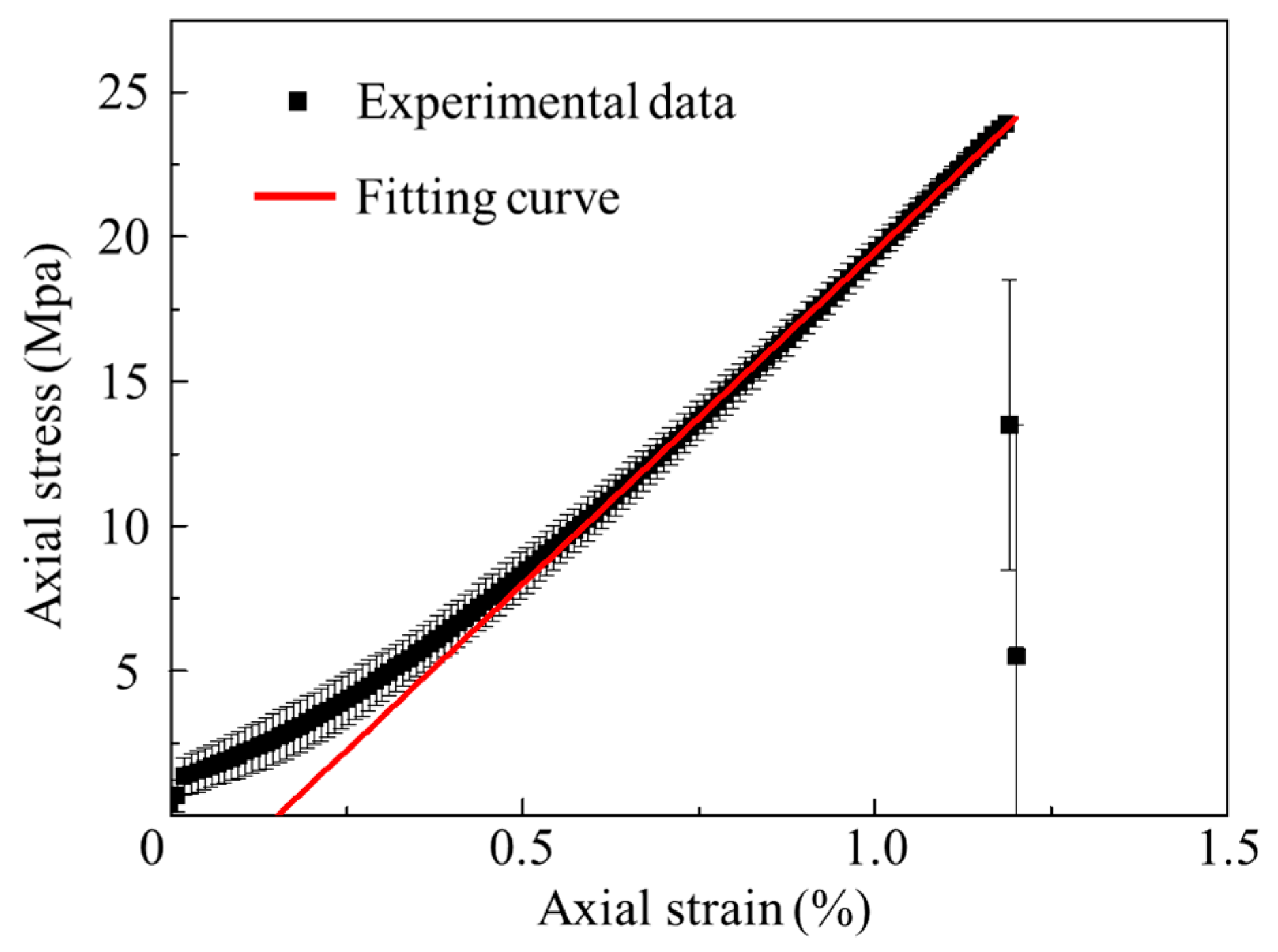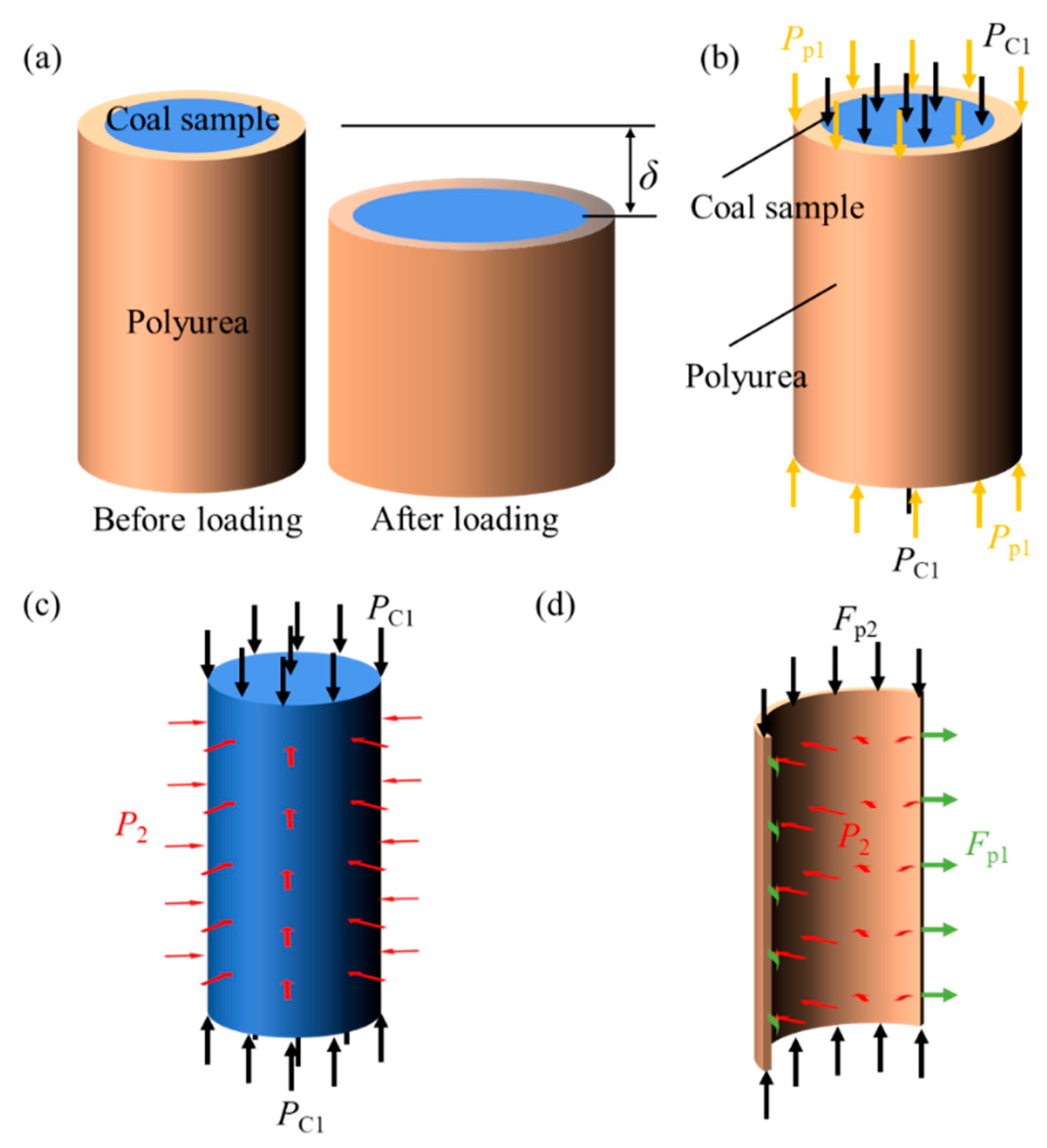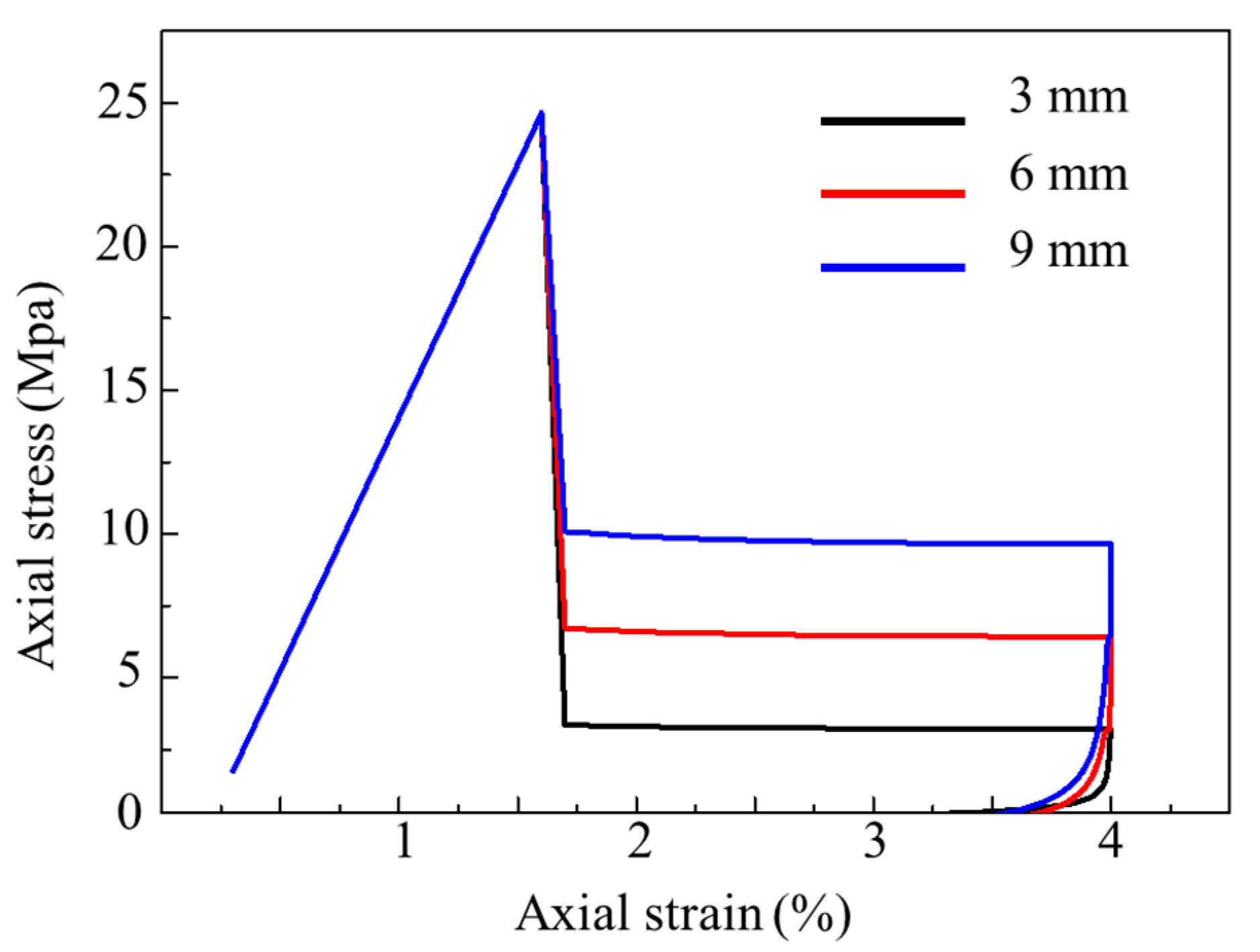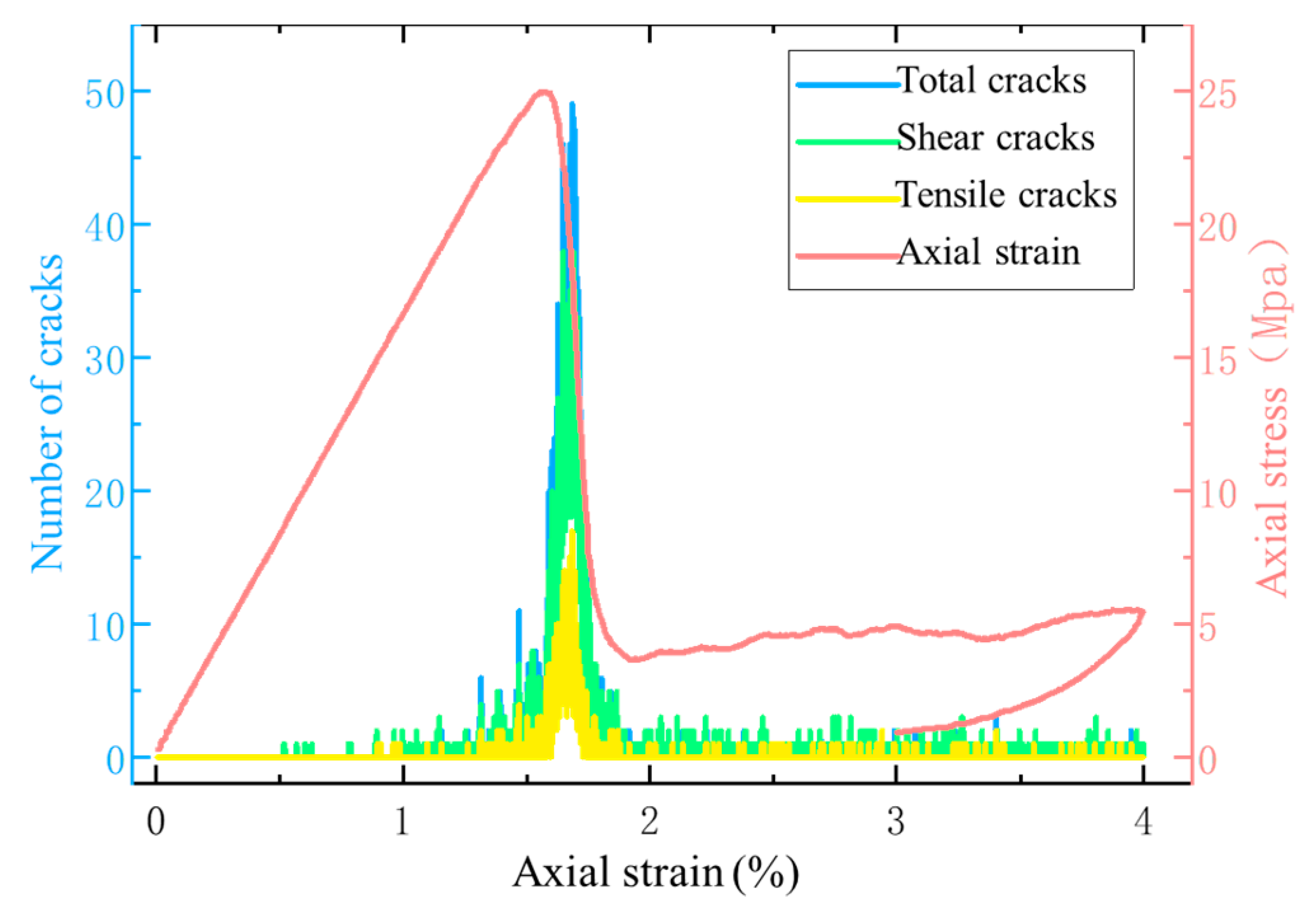Study on the Load-Bearing and Mechanical Properties of Coal Specimens Under Uniaxial Compression with Polyurea Spraying
Abstract
1. Introduction
2. Sample Processing and Preparation
3. Uniaxial Compression Test and Particle Flow Numerical Simulation
3.1. Uniaxial Compression Test
3.2. Construction of the Particle Flow Numerical Model
4. Theoretical Analysis of the Load-Bearing Mechanical Characteristics of Coal Under Polyurea Spray Coating Conditions
5. Load-Bearing Mechanical Characteristics of Coal Under Sprayed Coating Conditions
5.1. Analysis of Laboratory Experiment Results
5.2. Analysis of Numerical Simulation Results
6. Conclusions
- (1)
- The spraying of polyurea significantly improves the mechanical load-bearing properties of coal specimens, particularly after brittle failure. The confining pressure exerted by polyurea on the coal enhances the frictional resistance between internal fractures, thereby delaying the occurrence of collapse and effectively increasing the residual strength of the coal. This finding underscores the critical role of polyurea in coal mine support.
- (2)
- Although a polyurea coating is generally thin, its effect on the mechanical performance of the specimen at the elastic stage is relatively limited. Our results show that the elastic modulus of polyurea is much lower than that of coal specimens. Hence, in the early loading phase, the coating has no significant influence on the stress–strain response. In engineering applications, balancing the coating thickness and material properties is essential to meet the requirements of different working conditions.
- (3)
- The theoretical model developed in this study successfully predicts the deformation behavior of coal specimens sprayed with polyurea. The model reflects the stress–strain relationship of the specimens during the loading process; it also explains the confining pressure effect of the polyurea coating and changes in the friction coefficient after brittle failure. The model provides valuable insights into the complex interactions between the coating and the coal body.
- (4)
- As a novel temporary support material, polyurea coatings demonstrate significant potential for widespread application in coal mining and other extraction operations. Our results are expected to promote the development of spraying support technology in optimizing the material properties, spraying technology, and application scenarios of polyurea coatings; they also provide guidance for engineering practice.
Author Contributions
Funding
Institutional Review Board Statement
Informed Consent Statement
Data Availability Statement
Conflicts of Interest
References
- Kolapo, P.; Onifade, M.; Said, K.O.; Amwaama, M.; Aladejare, A.E.; Lawal, A.I.; Akinseye, P.O. On the application of the novel thin spray-on liner (TSL): A progress report in mining operations. Geotech. Geol. Eng. 2021, 39, 5445–5477. [Google Scholar]
- Tang, Y.; Tang, B.; Cheng, H. New prefabricated support structure for TBM tunneling in complex strata of coal mines: Engineering practice. Coal Sci. Technol. 2024, 52, 68–75. [Google Scholar]
- Du Plessis, M.; Malan, D.F. Investigating the use of polymer-modified cementitious thin spray-on liners as stope face support. Int. J. Rock Mech. Min. Sci. 2021, 142, 104728. [Google Scholar] [CrossRef]
- Roache, B.; Jardine, J.; Sainsbury, B. Thin spray liners for face support at Kanmantoo. In Proceedings of the Underground Operators Conference, Brisbane, QLD, Australia, 27–29 March 2023. [Google Scholar]
- Kang, H.; Jiang, P.; Song, D.; Lei, Y.; Li, Z.; Wang, Z.; Zhang, X.; Li, F.; Han, C.; Wang, R. Drilling and anchoring integrated intelligent rapid excavation complete equipment. J. Intell. Mine 2023, 4, 9–14. [Google Scholar]
- Kang, H.; Jiang, P.; Wang, Z.; Zhang, X.; Liu, C.; Luo, C.; Wei, Y.; Guo, J.; Chen, Z.; Wang, R.; et al. Coal roadway rapid driving technology and equipment with integrated drilling and anchoring and its application. J. China Coal Soc. 2024, 49, 131–151. [Google Scholar]
- Kang, H.; Jiang, P.; Gao, F.; Wang, Z.; Liu, C.; Yang, J. Analysis on stability of rock surrounding heading faces and technical approaches for rapid heading. J. China Coal Soc. 2021, 46, 2023–2045. [Google Scholar]
- Wang, H. Present Status and Development of Mine Roadway Heading Technology and Equipment in China Coal Mine. Coal Sci. Technol. 2010, 38, 57–62. [Google Scholar]
- Mpunzi, P.; Masethe, R.; Rizwan, M.; Stacey, T. Enhancement of the tensile strengths of rock and shotcrete by thin spray-on liners. Tunn. Undergr. Space Technol. 2015, 49, 369–375. [Google Scholar]
- Qiao, Q.; Nemcik, J.; Porter, I.; Baafi, E. Laboratory investigation of support mechanism of thin spray-on liner for pillar reinforcement. Géotech. Lett. 2014, 4, 317–321. [Google Scholar]
- Zhao, Y.; Fu, X.; Shi, Y.; Zhao, B.; Fu, X.; Zhang, X.; Chen, Y. Research on Mechanical Behavior and Energy Evolution of Coal and Rocks with Different Thin Spray-On Liners Thickness under Uniaxial Compressive Loading. Sustainability 2022, 14, 5909. [Google Scholar] [CrossRef]
- Kanda, M.J.; Stacey, T.R. Review of the practical effectiveness of thin spray-on liners based on information from suppliers and observations from the mining industry. In Proceedings of the MGR 2019, First International Conference on Mining Geomechanical Risk, Perth, Australia, 9–11 April 2019; Australian Centre for Geomechanics: Perth, Australia, 2019; pp. 443–458. [Google Scholar]
- Shan, Z.J.; Porter, I.; Nemcik, J.; Zhang, Z.Y. Investigation on the Rock Surface Support Performance of Welded Steel Mesh and Thin Spray-On Liners Using Full-Scale Laboratory Testing. Rock Mech. Rock Eng. 2020, 53, 171–183. [Google Scholar]
- Ozturk, H.; Guner, D. Laboratory and distinct element analysis of the deformability behaviour of thin spray-on liners. Int. J. Rock Mech. Min. Sci. 2019, 123, 104118. [Google Scholar]
- Kouchesfehani, Z.K.; Tehrani, A.D.; Najafi, M.; Syar, J. Laboratory testing of invert-cut corrugated metal pipes renewed with polymeric spray applied pipe lining. Transp. Geotech. 2020, 25, 100413. [Google Scholar]
- Kang, H.; Li, W.; Gao, F.; Yang, J. Grouting theories and technologies for the reinforcement of fractured rocks surrounding deep roadways. Deep Undergr. Sci. Eng. 2023, 2, 2–19. [Google Scholar]
- Archibald, J.F.; Dirige, P.A. Development of thin, spray-on liner and composite superliner area supports for damage mitigation in blast- and rock burst-induced rock failure events. WIT Trans. Built Environ. 2006, 87, 10. [Google Scholar]
- Lau, V.; Saydam, S.; Cai, Y.; Mitra, R. Laboratory Investigation of Support Mechanism for Thin Spray-on Liners. In Proceedings of the 12th International Conference of International Association for Computer Methods and Advances in Geomechanics (IACMAG), Goa, India, 1–6 October 2008. [Google Scholar]
- Ozturk, H.; Guner, D. Failure analysis of thin spray-on liner coated rock cores. Eng. Fail. Anal. 2017, 79, 25–33. [Google Scholar]
- Guner, D.; Ozturk, H. Experimental and numerical analysis of the effects of curing time on tensile mechanical properties of thin spray-on liners. Rock Mech. Rock Eng. 2016, 49, 3205–3222. [Google Scholar]
- Chen, L.; Zhou, Z.; Liu, G.; Cui, X.; Dong, Q.; Cao, H. Effects of substrate materials and liner thickness on the adhesive strength of the novel thin spray-on liner. Adv. Mech. Eng. 2020, 12, 1687814020904574. [Google Scholar]
- Ozturk, H.; Tannant, D.D. Thin spray-on liner adhesive strength test method and effect of liner thickness on adhesion. Int. J. Rock Mech. Min. Sci. 2010, 47, 808–815. [Google Scholar]
- Li, Z.; Nocelli, B.; Saydam, S. Effect of rock strength and surface roughness on adhesion strength of thin spray-on liners. Int. J. Rock Mech. Min. Sci. 2017, 91, 195–202. [Google Scholar]
- Wang, C.; Zhang, C.; Yao, H.; Wang, N. Preparation and properties of modified fiber reinforced polyurea composites. Fine Chem. 2024, 8, 1–11. [Google Scholar]
- Li, B.; Zhang, J.; Liu, X.; Meng, T. Study on the coupling effect and failure mechanism of mesh fabriereinforced polyurea coating. J. Hydraul. Eng. 2024, 437, 136963. [Google Scholar]
- Gao, F.; Peng, X.; Yuan, G.; Liu, W. Laboratory investigation of scale effects in bursting failure of quasi-brittle materials. Int. J. Rock Mech. Min. Sci. 2023, 171, 105579. [Google Scholar]
- Li, B.; Liang, Y.; Zhang, L.; Zou, Q. Experimental investigation on compaction characteristics and permeability evolution of broken coal. Int. J. Rock Mech. Min. Sci. 2019, 118, 63–76. [Google Scholar]
- Shan, P.; Li, W.; Lai, X.; Zhang, S.; Chen, X.; Wu, X. Research on the Response Mechanism of Coal Rock Mass under Stress and Pressure. Materials 2023, 16, 3235. [Google Scholar] [CrossRef]











Disclaimer/Publisher’s Note: The statements, opinions and data contained in all publications are solely those of the individual author(s) and contributor(s) and not of MDPI and/or the editor(s). MDPI and/or the editor(s) disclaim responsibility for any injury to people or property resulting from any ideas, methods, instructions or products referred to in the content. |
© 2025 by the authors. Licensee MDPI, Basel, Switzerland. This article is an open access article distributed under the terms and conditions of the Creative Commons Attribution (CC BY) license (https://creativecommons.org/licenses/by/4.0/).
Share and Cite
Cao, S.; Yang, J.; Hao, D. Study on the Load-Bearing and Mechanical Properties of Coal Specimens Under Uniaxial Compression with Polyurea Spraying. Appl. Sci. 2025, 15, 3486. https://doi.org/10.3390/app15073486
Cao S, Yang J, Hao D. Study on the Load-Bearing and Mechanical Properties of Coal Specimens Under Uniaxial Compression with Polyurea Spraying. Applied Sciences. 2025; 15(7):3486. https://doi.org/10.3390/app15073486
Chicago/Turabian StyleCao, Shuwen, Jinhong Yang, and Dingyi Hao. 2025. "Study on the Load-Bearing and Mechanical Properties of Coal Specimens Under Uniaxial Compression with Polyurea Spraying" Applied Sciences 15, no. 7: 3486. https://doi.org/10.3390/app15073486
APA StyleCao, S., Yang, J., & Hao, D. (2025). Study on the Load-Bearing and Mechanical Properties of Coal Specimens Under Uniaxial Compression with Polyurea Spraying. Applied Sciences, 15(7), 3486. https://doi.org/10.3390/app15073486




